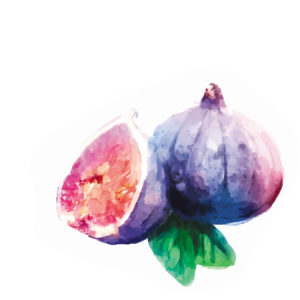For those who are passionate about perfectly ripened, locally-grown fruit, the late- spring and early-summer farmers’ market is filled with sweet surprises. Plump, juicy berries are now joined by long-awaited treasures like cherries, apricots, and figs—arguably the most voluptuous fruit of all.
 This preliminary fig season is far too brief for many of us. So, after eating my fill of figs out-of-hand, in salads, tarts, pizza, or simply enrobed in prosciutto, I longed to capture their unique flavor to carry me through leaner times. Rather than immersing myself in the traditional canning process, I now turn to this quick and easy recipe.
This preliminary fig season is far too brief for many of us. So, after eating my fill of figs out-of-hand, in salads, tarts, pizza, or simply enrobed in prosciutto, I longed to capture their unique flavor to carry me through leaner times. Rather than immersing myself in the traditional canning process, I now turn to this quick and easy recipe.
The following small-batch condiment can last for weeks—even months—in the refrigerator, providing that I don’t sneak a spoonful or two every time I wander through the kitchen. It is filled with figgy goodness! And, the addition of a whole lemon—skin, pith, and all—makes this recipe pleasantly piquant, and the walnuts add a touch of crunch.
Although I most frequently enjoy fig conserve spooned onto a warm, buttery scone or toasted English muffin, there are plenty of other uses for this recipe:
–Slather your favorite soft cheese (goat, brie, or blue) over crostini, or spoon it onto a leaf of Belgian endive; then top with a dab of fig conserve and a few tiny arugula leaves, or chopped fresh thyme or rosemary.
–Spread fig conserve over a wheel—or even a wedge—of ripe brie and top with more toasted walnuts.
–Serve a small bowl of fig conserve with cheese or charcuterie platters.
–Serve fig conserve as a condiment alongside roast pork or chops. When the main course is baked ham, serve fig conserve with warm buttermilk biscuits.
–Squeeze fresh lemon juice over a plain grilled chicken breast, and serve a spoonful of fig conserve on the side.
–Dollop fig conserve over a scoop of vanilla ice cream; then drizzle with a bit of honey and top with finely chopped crystallized ginger or candied lemon zest.
–Smear wheat meal digestive biscuits or gingersnaps with mascarpone or cream cheese, and top with a dab of fig conserve.
–Pack fig conserve into a decorative jar, tie with a raffia bow, and present to your host as a gift.
Fig Conserve
1/4 cup California walnut halves and pieces
1 whole lemon, rinsed well and patted dry
1 pint Black Mission or other firm but ripe figs, stemmed, and halved if large
1 cup granulated sugar
1 pinch of salt
- Preheat the oven to 350 degrees. Spread the walnuts in a small baking dish and bake, turning once or twice, until lightly toasted and fragrant, 7 to 10 minutes. Let cool, then chop coarsely.
- Cut the lemon into quarters and discard any seeds.
- With a large, sharp knife or in a food processor, pulsing the machine on and off, coarsely chop the whole lemon. Scrape the chopped lemon and any accumulated juices into a heavy-bottomed medium saucepan.
- Stir the figs, sugar, and salt into the lemon and bring to a boil over medium-high heat. Reduce the heat to maintain a low boil and cook, stirring often, until the sugar has melted and the mixture has thickened, 25 to 30 minutes. Set aside to cool to room temperature. Stir in the walnuts and transfer to a covered container. Refrigerate until serving. Makes 2 1/2 to 3 cups.
Figalicious Facts
–The fig is one of the oldest cultivated fruits. Since it is nutritious and easily preserved by drying, it became a staple of people in southern Europe and Arabia.
–According to the bible figs grew in the Garden of Eden, for it was fig leaves that Adam and Eve reportedly used to cover their nakedness after eating the forbidden fruit.
–In 1769 Father Junipero Serra planted California’s first figs in the San Diego area. California now produces 95% of the U.S. fig crop and is the 3rd largest producer in the world, trailing closely behind Turkey and Greece.
–Because ripe figs are fragile and do not travel well, each year around 30 million pounds of the California crop are transformed into dried figs.
–Figs are in season twice each year: first in June through July; and again in August through October or November.
–Figs must remain on the tree until fully ripe, as they do not ripen once they have been picked. For this reason, buy only figs that are very soft and ready to eat.
–Fresh Black Mission figs are teardrop-shaped with purple-black skin and strawberry-colored flesh inside. Brown Turkey figs are chubby, squat teardrops, with thicker, reddish-brown skin and pink interior. Kadota figs have thin green skin and pale flesh.
–Rich in fiber, iron, and calcium, figs are actually inverted flowers containing thousands of edible seeds.
–1 large fig weighs in at about 47 calories.
–Place whole, un-washed figs in a brown paper bag and store in the crisper drawer of the refrigerator for up to 5 days.
The Danville Certified Farmers’ Market, located at Railroad & Prospect, is open every Saturday, rain or shine, from 9 a.m. until 1 p.m. For specific crop information call the Pacific Coast Farmers’ Market Association at 1-800-949-FARM, or visit their web site at www.pcfma.org. This market is made possible through the generous support of the Town of Danville. Please show your appreciation by patronizing the many fine shops and restaurants located in downtown Danville. Buy fresh. Buy local. Live well!
Leave a Reply